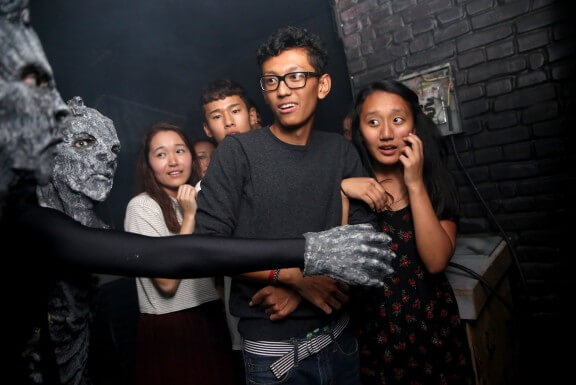 Stephanie Cleau and Mathieu Amalric go into noir territory in “The Blue Room.”
Stephanie Cleau and Mathieu Amalric go into noir territory in “The Blue Room.”
Credit: IFC Films
‘The Blue Room’
Director: Mathieu Amalric
Stars: Mathieu Amalric, Stephanie Cleau
Rating: NR
4 (out of 5) Globes
Mathieu Amalric is best known as an actor, and a peerlessly entertaining/talented one. Along with “The Diving Bell and the Butterfly,” he’s also in a committed director-star relationship with Arnaud Desplechin, as witness “Kings and Queen” and “A Christmas Tale,” and seems to be working his way through his favorite filmmakers. But before he acted, he was a filmmaker himself. In fact, he won the Best Director award at Cannes in 2010 for “On Tour.” His follow-up is nothing if not unique. It’s a slender film of a slender novel by oft-adapted French crime great Georges Simenon, but one that plays like if Alain Resnais did film noir. (It’s worth noting Amalric worked for Resnais twice.)
That abstract nature comes from the novel itself, which very, very gradually parcels out tiny fragments of its story. Amalric himself plays Julien, who’s introduced in the titular room, which mostly contains a spacious bed he shares with Esther (Stephanie Cleau). They go through the type of clothesless hangout session that comes from people madly in love. But from their body language and talk, we can tell they’re not married. (In real life, Cleau is Amalric’s girlfriend, and she helped him write this script.) And Amalric suddenly cuts to Julien being grilled police over a murder. But who’s murdered? And what’s the deal with his wife (Lea Drucker), to whom he keeps returning?
One of many things that distinguishes this coolly assured effort is that it has no interest in having a center of gravity. We’re not sure which is present, what is real or simply faulty memory. Most of the film traps us not only in Julien’s brain but drags us in every direction his brain goes. Something makes him think of canoodling with Esther, and we’re back again, looking at the same, obsessed-upon image, showing the way images lodge themselves in the mind, dialed up whenever one wants it.
But “The Blue Room” is doing more than that. The crux of the film is showing the chasmic disparity between our inner thoughts and our actions — between the intangible and cold, hard factual. Julien is persistently grilled by police to explain his actions in falsifiable ways. Sometimes he can’t explain what he did that doesn’t sound incriminating. Other times the memory betrays him, showing that he’s lying. It’s a film about the mind as one of the world’s great mysteries, even to its user — capable of deception, self-deception and emotions we don’t know how to process.
If this sounds like a concept being worked out, then it really only feels that way in the final third, when Amalric makes the ballsy move to suddenly hop outside of Julien’s mind and observe the trial that will finally determine his fate. It’s not a by-the-books courtroom scene, but it feels less like another narrative experiment and more like a conclusion to a theorem, making it seem like a mere exercise. It’s not a mere exercise, as the sensuous, restless and sometimes very funny first hour (of an hour-and-15) attests.
Follow Matt Prigge on Twitter @mattprigge

















